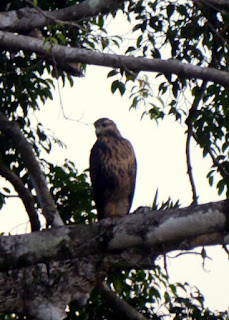After breakfast, we headed off in small boats to visit the
locks and the former American fort here. We were very fortunate to arrive as a
large ship was entering the new canal, because there are many fewer of them. We landed at the site of a
former Yacht Club that operated for the residents of the Fort. The gates
operate differently in the new locks. Instead of gates that swing out or in and
meet in the middle, these slide from one side to the other in pairs for safety.
They also function as one-lane roads across the canal when they are closed,
which is very handy.
 |
This ship is moving to the new locks. It has 4 tugs on this side
and probably another 2 or more on the other side. |
We spent some time
watching the big ship move from its first lock and the clever way the gates
slide across into place. Then we took a very short nature walk, which touted
both animals and plants, but the only animal we saw was one butterfly. There
was also a very informative 12 minute movie that showed the history of building
the extra big lane. The requirement for it was actually understood in the
1930's and the U.S. started construction in 1939, but WWII intervened and work
was stopped. It was not restarted until Panama got control of the canal. In
2004, a referendum was required to make such a big investment
and it passed. It took several years to get construction going, but now it has been
operational for two years. They are still working out some
kinks in the system. For
instance, they had a plan to conserve up to 60% of the fresh water that would
otherwise be discharged as the down gates empty, but they are not
using it.
Back on the bus, we visited remnants of the Fort Davis on
this side and the non-military worker housing. Not only were there military
families here, the workers employed in the canal zone also had housing for
themselves and their families. Our canal guide, Ian, came to live in various
canal zone locations after his parents divorced and he moved in with his father
when he was in 4th grade. At the time, he spoke no English, but was thrust into
an American school and now has totally unaccented English as a result. He
initially lived in Gamboa, but two years later, his father was transferred here, so we got a very personalized tour. We
saw his elementary school and where he was posted as a safety patrol. Many of
the buildings have been sold and upgraded, but some are getting pretty
derelict.
 |
| Original look of a house. |
 |
| A fixed up version. |
 |
Most of the houses are stucco on concrete block, but this older
house is wood on concrete stilts. |
Once we reboarded our boat, we saw our pilot board for this trip through the
locks. As lunch started, we entered the locks, right behind a U.S. Navy ship Bob Hope in the lock ahead of us. This time we were joined by a
much bigger ship. As we were getting ready to go in the west lane, a huge car
shipping freighter entered the east lane and we pretty much proceeded along
side it.
Out of the locks, we sailed to a marina on the west side of the
entrance to the Caribbean and docked for the night. This marina used to be Fort
Sherman, and we spent about an hour walking around. We saw monkeys and hawks
and a lot of derelict buildings. Some are being used for the AeroNavy. (The
Panamanian army was disbanded after Noriega, but they have a coast guard and
decided they needed air support for it.)
 |
| Lighthouse |
 |
This bird had some dinner he was guarding just off the path.
Several times while we watched he went in to snatch a bite
before coming back to ensure we weren't going to try to grab it. |
 |
| AeroNaval housing |
Back on board, we had the Captain's dinner and then prepared
to depart in the morning.



















































